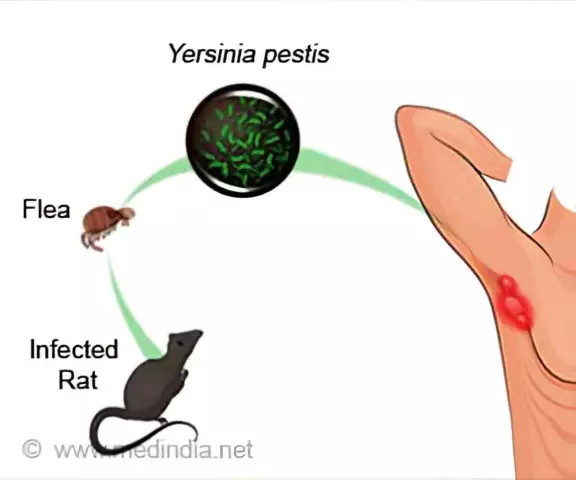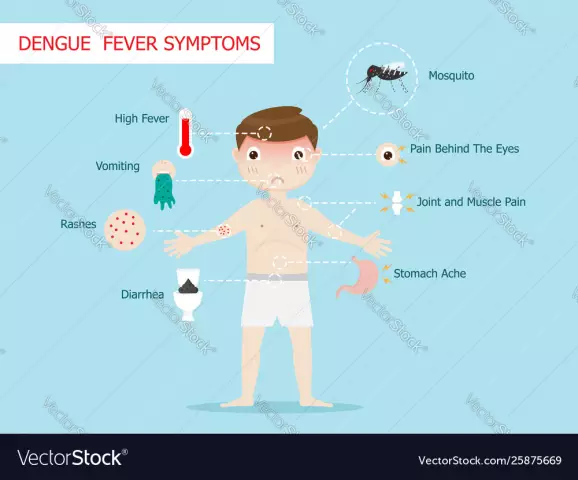- Author Rachel Wainwright [email protected].
- Public 2023-12-15 07:39.
- Last modified 2025-11-02 20:14.
Yersiniosis
General characteristics of the disease

Yersiniosis is an infectious disease characterized by a predominant lesion of the gastrointestinal tract, as well as generalized damage to the skin, joints, and other systems and organs.
Since this disease primarily affects the alimentary canal, it is also called intestinal yersiniosis.
The causative agent of the disease is a member of the family of intestinal bacteria of the species Yersinia enterocolitica. These microorganisms are extremely resistant to low temperatures, including freezing, but quickly die at temperatures exceeding 60 ° C, especially when boiling.
In addition, yersinia thrive at temperatures from +4 to +8 0 С, multiplying on food, which is why yersiniosis is often called "refrigerator disease".
Small rodents are carriers of the infection in the wild, but small ruminants and cows, which are capable of shedding the pathogen, pose a great danger to humans. Most often, Yersinia enters the human body through food, especially fresh vegetables. However, in addition to food and water, an already infected person is also a source of infection, since yersiniosis is also transmitted by contact (fecal-oral mechanism).
The risk of contracting this infection exists for all age groups, however, yersiniosis is most often observed in children aged 1 to 3 years. This disease is characterized by autumn-spring seasonality.
Yersiniosis symptoms
The incubation period usually lasts 1-2 days, but in some cases it can last up to 10 days. The symptoms of yersiniosis are in many ways reminiscent of gastroenteritis, gastroenterocolitis, enterocolitis, terminal ileitis.
Intestinal yersiniosis is characterized by abdominal pain, which can be persistent or cramping, vomiting, nausea, and fetid diarrhea. Stool during illness can be from 2 to 15 times a day, with an admixture of pus, mucus, and sometimes blood.
The symptoms of yersiniosis, in addition to intestinal damage, also indicate a general intoxication of the body - an increase or decrease in temperature, dehydration, toxicosis. For the onset of the disease, in some cases, the appearance of a small-spotted or punctate rash on the limbs and trunk is characteristic, and during this period of yersiniosis, meningeal syndrome and liver damage can be observed.
For the later period of this infection, the development of diseases such as erythema nodosum, mono- or polyarthritis, iritis, conjunctivitis, myocarditis, Reiter's syndrome is characteristic.
Intestinal yersiniosis can last from one week to several months.
Diagnosis and treatment of yersiniosis
Yersinia can be detected with the help of laboratory equipment in the feces and urine of a sick person, and in special cases - in blood, cerebrospinal fluid, bile, sputum, pus from abscesses. It is also possible to diagnose intestinal yersiniosis by detecting antibodies to the pathogen, which usually appear 7 days after infection. However, it is possible that the immune response may be weak or completely absent, as a result of which antibodies will not be detected. It is possible to speak confidently about infection with yersiniosis if antigens of the pathogen or its DNA are found in the blood or feces.
Treatment of yersiniosis, like other intestinal infections, involves detoxification therapy, as well as replacement of lost fluids. Antibiotic therapy is also a must in the treatment of yersiniosis. The causative agents of this disease, as a rule, are sensitive to chloramphenicol, tetracyclines, biseptol. If these drugs are ineffective, fluoroquinols (ofloxacin, ciprofloxacin) are prescribed, as well as intramuscular injections of gentamicin.
After the body temperature returns to normal, the treatment of yersiniosis with anbiotics is carried out for another 10 days.
In a situation where the symptoms of the disease persist, and the pathogens are no longer in the body, corticosteroids are used, the action of which is aimed at suppressing the immune response. With the development of arthritis against the background of infection with yersinia, such non-steroidal anti-inflammatory drugs as aspirin, voltaren, diclofenac, ibuprofen are prescribed.
Intestinal yersiniosis in children

Despite the fact that in most cases of yersiniosis in children has symptoms typical of this infection, there are some features of the clinical picture of the disease in this age group. Firstly, signs of infection such as intoxication, fever, fever are more pronounced than in adults. Secondly, children during illness become adynamic, restless, loss of consciousness, convulsions, hemodynamic disorders are possible. Yersiniosis is especially difficult in children of the first year of life: dehydration is observed, lymph nodes, spleen enlarge, and respiratory syndrome manifests itself.
Prevention of yersiniosis
It is possible to prevent the disease of hierosiniosis if you adhere to the rules of storage and processing of food:
- raw vegetables and fruits must be washed well with warm water before use, remove rotten areas, and then scald with boiling water;
- do not store or consume products that have already expired;
- only freshly prepared salads should be eaten;
- meat, especially pork, should be subjected to prolonged heat treatment;
- do not store peeled vegetables in water, including in the refrigerator.
Prevention of intestinal yersiniosis involves the timely identification of infected people and their isolation, as well as disinfection of premises.
YouTube video related to the article:
The information is generalized and provided for informational purposes only. At the first sign of illness, see your doctor. Self-medication is hazardous to health!






